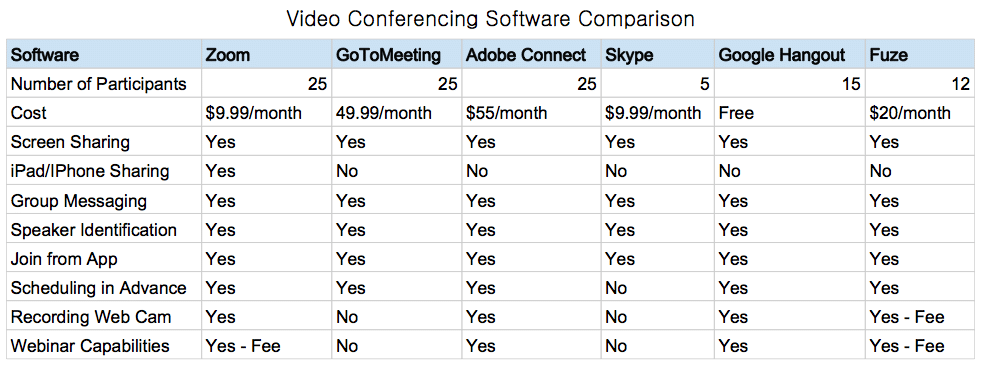If you paid me a dollar for every minute I’ve spent on a conference call in my life, I probably would never have to work again. But I like working—and that’s exactly why I don’t like conference calls.
I know there are forms of business communication less efficient that conference calls, but I’m having trouble thinking of them right now. People drop in and out, talk over each other, lose track of who’s saying what—and the more voices on the line, the more confusing it all becomes.
Do two or three of these back to back, and it’s enough to make you doubt the future of the species. Thankfully, I’ve got the solution—at least for me and my team. But I bet it’ll work for you too.
If you’d like to avoid the irritation and disappointment of conference calls, but need to collaborate with people in different departments, towns, states, even countries, then video conferencing is the answer.
Hold up!
If I had heard myself say that even just a couple of years ago, I would have rolled my eyes and kept looking for a better answer. If you’re like me, you’ve used video conferencing software that was somehow even worse than conference calling. Bad audio, lagging video—who’s got time for it?
But we started using Zoom sometime back, and I’m a believer. It is the better answer. First off, the sound is always clear and the image crisp. But that’s just the start.
Here are seven reasons why video conferencing with apps like Zoom beats the classic conference call practically every time:
- You can read people. It seems obvious, but talking with a disembodied voice is less than ideal. If you doubt me, try having a conversation with a nearby coworker with your eyes closed. Facial expressions and gestures are important—sometimes vital—for being understood.
There’s debate about just how important, but nobody assumes body language is irrelevant. Yes, you can be understood without it, but why lose all those visual cues if you don’t need to?
- It removes the guesswork and awkward moments. Don’t you hate it in conference calls when someone starts going, but you have no idea who’s talking? Video conference software not only accommodates multiple people—Zoom handles more than two dozen—it can also keep everyone distinct by showing you who’s talking.
We sometimes do big team meetings. We’ve got people from all over on at once, and this is a big help. I’ve noticed that it even cuts down on the tendency to talk over each other.
- You can finally see what other callers are seeing. This isn’t true for all video conferencing apps, but Zoom lets callers screen share. This is huge for collaborating on design.
Instead of imagining what someone is saying about a layout or a comp, they can show you exactly what they mean. It’s like you’re hunched over the same screen.
- You can share links via chat. How many times have you wanted everyone on the call to go to a page? Some URLs are easy enough, but others are unintelligible and practically impossible to communicate over the phone.
Sharing the link is way faster than trying to say it orally and have everyone type it in correctly. Zoom’s chat feature means it’s as simple as cutting and pasting.
- It keeps people on task. I don’t want to sound cynical, but I think a lot of people use conference calls as found time to catch up on their email or RSS feeds.
That might be the consequence of the organizer just not knowing how to run a meeting, but we’ve found that visual contact keeps everyone engaged, and that means meetings go quicker and more gets done.
- You can record the entire conversation. There’s no replacement for good note taking, but this feature is amazing. Everyone has to give their permission, but it’s a great way to save the discussion for posterity—or just next week.
- It enhances relationships. One of the things I love about my team is the talent that I’ve been able to pull together from all over. But the the lack of proximity could be a damper on our camaraderie.
Video conferencing has helped us literally bridge that gap, enabling us to connect on a much more human level than mere phone time ever could. This goes back to the first point: You can read people. It’s added a richness to our working relationships that improves our work and enhances our joy on the job.
Team work is just coordinating effort. Don’t you want to use the best tools for the job? In my recent experience video conferencing is the right tool for almost any collaboration that would have previously required a phone call.
It’s more efficient, more fun, more relational, and more ultimately just more effective.
As a postscript, several readers wondered about why I singled out Zoom. Though my main point in the post was about why video conferencing in general beats conference calling, I thought a comparison chart might be useful.

Disclosure of Material Connection: Some of the links in the post above are “affiliate links.” This means if you click on the link and purchase the item, we will receive an affiliate commission. Regardless, we only recommend products or services we use and believe will add value to our readers. We are disclosing this in accordance with the Federal Trade Commission’s 16 CFR, Part 255: “Guides Concerning the Use of Endorsements and Testimonials in Advertising.









